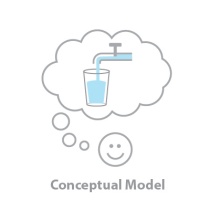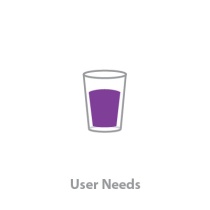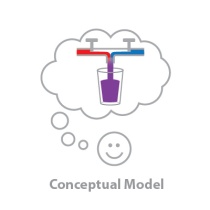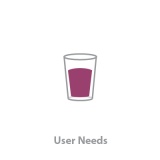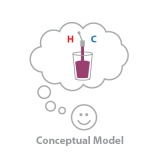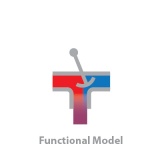There is a difference between a conceptual model (the way a user thinks about a system), and a functional model (how a system actually works). There is also a difference between what a system does and what the user wants. We tend to overlook these differences to get things done, but if you take the time to identify the needs and models, you’ll find opportunity in the gaps.
Let’s look at the humble faucet (hat tip to Donald Norman). First, faucets were positioned over sinks and tubs to save the user a trip to the well. At this point the functional model and the conceptual model and the user need all aligned. By turning a lever or wheel the user could adjust the amount of water coming out of the faucet. The user might memorize which direction to turn the control, but no advanced technical knowledge was need to understand how a valve works.
The addition of heated water complicated the device and at the same time users were adjusting their needs to the new capabilities. Initially, the hot water was added as a second spigot, but users had moved their focus from the receptacle to the stream and they wanted moving water, not just a full bowl or bucket. And users didn’t want one cold stream and one scalding stream, they wanted to control the temperature and flow of a single stream. This was solved by mixing the two sources after the valves. The resulting device was still simple enough to be understood by users and they were able to manipulate the system to match their needs.
But the cognitive load on a system like this is significantly higher [than the single temperature spigot] because the relationship between the user needs and the functional model is no longer one-to-one. Users want a specific temperature and flow, but adjusting the temperature also changes the flow and vice versa. So any adjustment to a single user need requires two adjustments to the system. The burden of translating user needs to the functional model is put on the user. With this complexity comes errors, and opportunity.
In the 1940s Alfred Moen burned his hand under a faucet and thought, “you ought to be able to get what you want out of a faucet.” He invented the single handle mixing faucet to solve this problem. Now the movements of the controls mapped directly to the user needs — forward and back for flow, and left and right for temperature — and the user no longer needed to understand how the system actually worked.
In the 50’s housing boom after WWII the single handle mixing faucet became an icon of modern living and the cornerstone of one of the largest plumbing product companies in the world. So look at those gaps between the user needs, conceptual model, and the functional model, because that’s where opportunities lie.
Addendum. Here’s a question now that we’re thinking about faucets. There is another gap between the user needs and the functional model. It’s that pipe full of cold water sitting between the faucet and the water heater. Users know they need to flush the cold water out to get to the hot water, but again the user has to translate their need onto the functional model. What innovations can you think of to close that gap?

